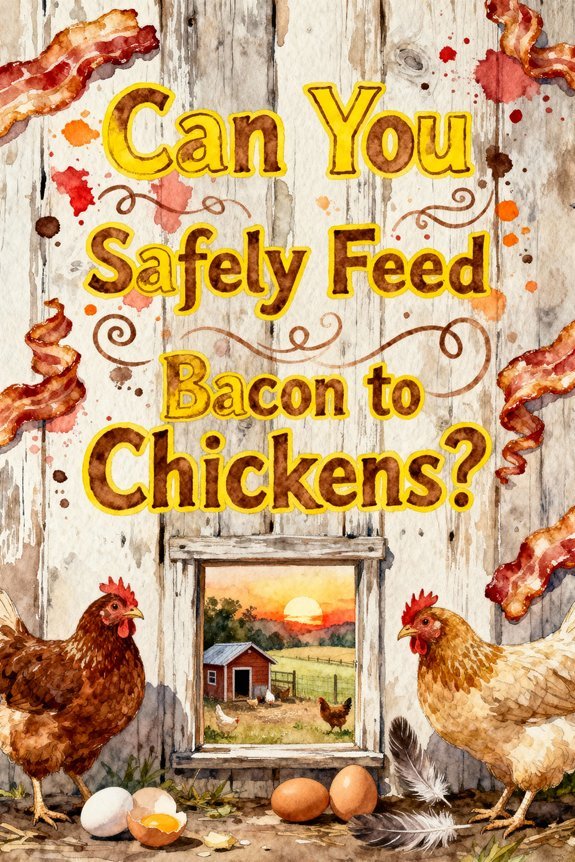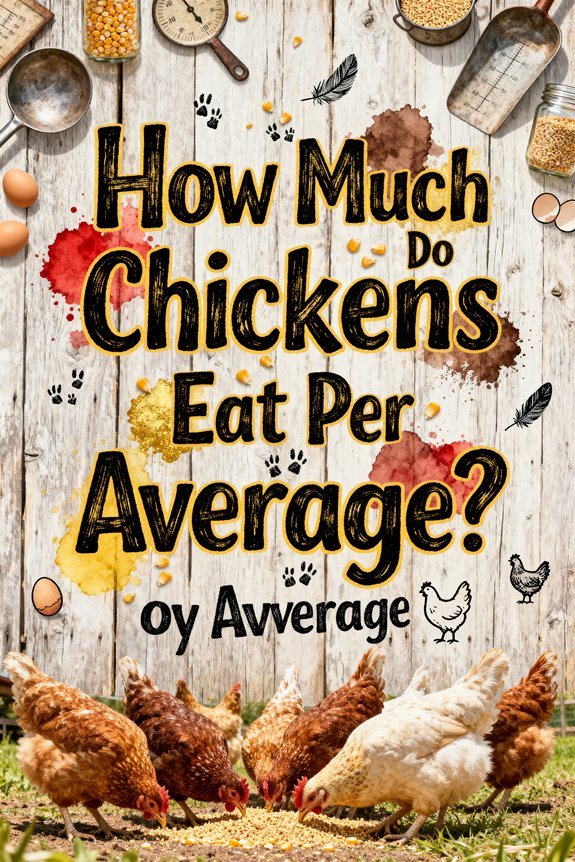Can You Safely Feed Bacon to Chickens?
You shouldn’t feed bacon to your chickens as it poses significant health risks. The high salt content can trigger sodium toxicosis, while preservatives like nitrites compromise their immune system. Raw bacon may harbor dangerous bacteria, and its excessive fat disrupts normal digestion. Instead, offer protein-rich alternatives like black soldier fly larvae, sprouted grains, or lean cooked meats. Understanding safe protein treats will help you maintain your flock’s ideal health and prevent serious complications.
Understanding the Risks of Feeding Bacon to Chickens
While bacon might seem like an enticing treat for chickens, it poses several significant health risks that can compromise your flock’s wellbeing. Raw bacon can harbor dangerous bacteria like Salmonella, Campylobacter, and Clostridium perfringens, leading to serious foodborne illnesses in your chickens. Even when cooked, bacon’s high fat content and preservatives remain problematic. Since chickens require a varied diet, offering balanced alternatives to processed meats will better support their health and development.
The digestive hazards are equally concerning. Bacon bones can splinter and cause throat injuries or internal damage, while the excessive fat content disrupts normal digestion and can lead to obesity. You’ll also notice aggressive feeding behaviors and competition among your chickens when offering fatty treats like bacon. Additionally, the indigestible parts such as gristle may harm their gastrointestinal tract, making bacon an unsuitable food choice for maintaining your flock’s health. The high salt content in bacon makes it particularly dangerous as a regular dietary component for chickens.
Health Impacts of Salt and Preservatives on Poultry
When chickens consume bacon’s high salt content and preservatives, they face serious health risks that can lead to sodium toxicosis and organ failure. Salt levels exceeding recommended poultry nutrition guidelines of 0.15% can cause brain sodium concentrations to rise above 1,700 ppm, triggering severe neurological symptoms and edema. Proper feed storage conditions significantly impact how nutrients are preserved and made available to chickens.
Your chickens may initially show subtle signs like dullness and appetite loss before developing more severe complications. The preservatives in bacon, including nitrites and nitrates, can compromise their immune system and disrupt gut health. Additionally, excess salt affects egg quality in laying hens and meat texture in broilers through altered water retention. For ideal flock health, you’ll need to carefully monitor sodium intake and avoid processed meats that could expose your birds to dangerous preservatives.
Safe Alternatives to Bacon for Protein Treats
Instead of feeding bacon to your chickens, you’ll find numerous protein-rich alternatives that provide essential nutrients without the risks of excess sodium and preservatives. Consider incorporating insect protein sources like Black Soldier Fly Larvae, which deliver 75 times more calcium than mealworms, or crickets that align with your flock’s natural foraging instincts. Sprouted fodder feed provides an excellent protein-rich alternative while improving digestibility.
You can offer plant snacks such as sprouted grains and cooked legumes to create a balanced protein intake. Sourdough starter discard can be mixed with feed to support digestion and immune health. Hard-boiled eggs with shells provide excellent calcium and protein, particularly during molting seasons. For additional variety, try offering small amounts of cooked fish, which supplies omega-3 fatty acids and supports feather quality. Old English Game chickens are especially active birds that benefit from diverse protein sources to maintain their muscular build. Remember to rotate these protein sources to maintain dietary diversity while maintaining proper nutrition levels.
Best Practices for Meat-Based Chicken Treats
Three fundamental principles guide the safe feeding of meat-based treats to chickens: lean protein selection, proper preparation, and controlled portions. When selecting meats, choose unprocessed, lean cuts of chicken, beef, or fish that are free from seasonings and additives. Your meat preparation can include either raw or cooked options, but make certain the meat is fresh and served immediately to prevent spoilage.
Establish a treat frequency that maintains nutritional balance – offer meat treats sparingly and mix them with grains when possible. Feed these treats away from the coop’s interior, and only provide amounts your flock can consume quickly. Monitor your birds for any adverse reactions and adjust portions accordingly. Remember to use clean feeding equipment and maintain proper food handling practices to minimize contamination risks. Since chickens are natural omnivores, they can safely consume meat as part of their varied diet.
Warning Signs Your Chickens Have Consumed Too Much Bacon
Monitoring your chickens for signs of bacon overconsumption is crucial to prevent serious health complications. Watch for diarrhea symptoms, including loose stools and visible digestive upset, which often indicate your birds have eaten too much processed meat. Key dehydration indicators include excessive thirst, sunken eyes, and dry mucous membranes from salt toxicity.
You’ll notice behavioral changes like increased aggression, frantic feeding, and excessive vocalization when chickens consume too much bacon fat. Keeping bacon treats to once a week helps prevent these issues. Look for signs of nutritional imbalance, including poor feather condition and reduced egg production. Your flock may display weakness, lethargy, or respiratory distress if they’ve consumed spoiled bacon containing harmful bacteria. If you observe these warning signs, immediately remove bacon from their diet and guarantee fresh water is readily available.




